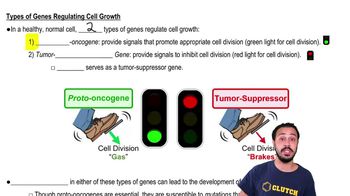Table of contents
- 1. Introduction to Biology2h 42m
- 2. Chemistry3h 40m
- 3. Water1h 26m
- 4. Biomolecules2h 23m
- 5. Cell Components2h 26m
- 6. The Membrane2h 31m
- 7. Energy and Metabolism2h 0m
- 8. Respiration2h 40m
- 9. Photosynthesis2h 49m
- 10. Cell Signaling59m
- 11. Cell Division2h 47m
- 12. Meiosis2h 0m
- 13. Mendelian Genetics4h 44m
- Introduction to Mendel's Experiments7m
- Genotype vs. Phenotype17m
- Punnett Squares13m
- Mendel's Experiments26m
- Mendel's Laws18m
- Monohybrid Crosses19m
- Test Crosses14m
- Dihybrid Crosses20m
- Punnett Square Probability26m
- Incomplete Dominance vs. Codominance20m
- Epistasis7m
- Non-Mendelian Genetics12m
- Pedigrees6m
- Autosomal Inheritance21m
- Sex-Linked Inheritance43m
- X-Inactivation9m
- 14. DNA Synthesis2h 27m
- 15. Gene Expression3h 20m
- 16. Regulation of Expression3h 31m
- Introduction to Regulation of Gene Expression13m
- Prokaryotic Gene Regulation via Operons27m
- The Lac Operon21m
- Glucose's Impact on Lac Operon25m
- The Trp Operon20m
- Review of the Lac Operon & Trp Operon11m
- Introduction to Eukaryotic Gene Regulation9m
- Eukaryotic Chromatin Modifications16m
- Eukaryotic Transcriptional Control22m
- Eukaryotic Post-Transcriptional Regulation28m
- Eukaryotic Post-Translational Regulation13m
- 17. Viruses37m
- 18. Biotechnology2h 58m
- 19. Genomics17m
- 20. Development1h 5m
- 21. Evolution3h 1m
- 22. Evolution of Populations3h 52m
- 23. Speciation1h 37m
- 24. History of Life on Earth2h 6m
- 25. Phylogeny2h 31m
- 26. Prokaryotes4h 59m
- 27. Protists1h 12m
- 28. Plants1h 22m
- 29. Fungi36m
- 30. Overview of Animals34m
- 31. Invertebrates1h 2m
- 32. Vertebrates50m
- 33. Plant Anatomy1h 3m
- 34. Vascular Plant Transport1h 2m
- 35. Soil37m
- 36. Plant Reproduction47m
- 37. Plant Sensation and Response1h 9m
- 38. Animal Form and Function1h 19m
- 39. Digestive System1h 10m
- 40. Circulatory System1h 57m
- 41. Immune System1h 12m
- 42. Osmoregulation and Excretion50m
- 43. Endocrine System1h 4m
- 44. Animal Reproduction1h 2m
- 45. Nervous System1h 55m
- 46. Sensory Systems46m
- 47. Muscle Systems23m
- 48. Ecology3h 11m
- Introduction to Ecology20m
- Biogeography14m
- Earth's Climate Patterns50m
- Introduction to Terrestrial Biomes10m
- Terrestrial Biomes: Near Equator13m
- Terrestrial Biomes: Temperate Regions10m
- Terrestrial Biomes: Northern Regions15m
- Introduction to Aquatic Biomes27m
- Freshwater Aquatic Biomes14m
- Marine Aquatic Biomes13m
- 49. Animal Behavior28m
- 50. Population Ecology3h 41m
- Introduction to Population Ecology28m
- Population Sampling Methods23m
- Life History12m
- Population Demography17m
- Factors Limiting Population Growth14m
- Introduction to Population Growth Models22m
- Linear Population Growth6m
- Exponential Population Growth29m
- Logistic Population Growth32m
- r/K Selection10m
- The Human Population22m
- 51. Community Ecology2h 46m
- Introduction to Community Ecology2m
- Introduction to Community Interactions9m
- Community Interactions: Competition (-/-)38m
- Community Interactions: Exploitation (+/-)23m
- Community Interactions: Mutualism (+/+) & Commensalism (+/0)9m
- Community Structure35m
- Community Dynamics26m
- Geographic Impact on Communities21m
- 52. Ecosystems2h 36m
- 53. Conservation Biology24m
11. Cell Division
Cancer
Problem 10`
Textbook Question
Proto-oncogenes can change into oncogenes that cause cancer. Which of the following best explains the presence of these potential time bombs in eukaryotic cells?
a. Proto-oncogenes first arose from viral infections.
b. Proto-oncogenes are mutant versions of normal genes.
c. Proto-oncogenes are genetic 'junk'.
d. Proto-oncogenes normally help regulate cell division.
 Verified step by step guidance
Verified step by step guidance1
Understand the role of proto-oncogenes: Proto-oncogenes are normal genes that play a crucial role in regulating cell growth and division. They are essential for normal cellular functions and development.
Recognize the transformation process: Proto-oncogenes can become oncogenes through mutations or increased expression. This transformation can lead to uncontrolled cell division, contributing to cancer development.
Evaluate the options: Consider each option provided in the problem. Option a suggests a viral origin, which is not typically how proto-oncogenes arise. Option b implies they are mutant versions, which is incorrect as they are normal genes before mutation. Option c labels them as genetic 'junk,' which is misleading as they have important regulatory functions.
Focus on the correct explanation: Option d states that proto-oncogenes normally help regulate cell division, which aligns with their biological role. They are not inherently harmful but can become problematic if altered.
Conclude with the best choice: Based on the understanding of proto-oncogenes, option d is the most accurate explanation of their presence in eukaryotic cells, highlighting their role in normal cellular processes.
 Verified video answer for a similar problem:
Verified video answer for a similar problem:This video solution was recommended by our tutors as helpful for the problem above
Video duration:
4mPlay a video:
Was this helpful?
Key Concepts
Here are the essential concepts you must grasp in order to answer the question correctly.
Proto-oncogenes
Proto-oncogenes are normal genes found in eukaryotic cells that play a crucial role in regulating cell growth and division. They encode proteins that help control the cell cycle, ensuring cells divide at the right time and maintain healthy tissue function. When mutated or abnormally expressed, proto-oncogenes can become oncogenes, leading to uncontrolled cell proliferation and cancer.
Recommended video:
Guided course

Types of Genes Regulating Cell Growth
Oncogenes
Oncogenes are mutated or overexpressed versions of proto-oncogenes that contribute to cancer development. These genes can lead to the production of proteins that drive excessive cell division, inhibit normal cell death, or promote other cancerous behaviors. Understanding oncogenes is crucial for developing targeted cancer therapies and understanding tumorigenesis.
Recommended video:
Guided course

Types of Genes Regulating Cell Growth
Cell Division Regulation
Cell division regulation is a fundamental biological process that ensures cells divide correctly and at appropriate times. It involves a complex network of signals and checkpoints that control the cell cycle, preventing errors that could lead to diseases like cancer. Proto-oncogenes are integral to this regulation, as they encode proteins that help manage these processes, highlighting their importance in maintaining cellular health.
Recommended video:
Guided course

Importance of Cell Division
Related Videos
Related Practice














